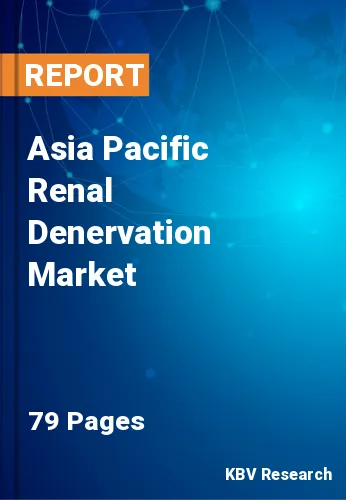The Asia Pacific Renal Denervation Market would witness Market growth of 38.8% CAGR during the forecast period (2022-2028).
Renal denervation has been a proposed technique to aid in the treatment of RH since it was initially utilized when hypertension remains uncontrolled after changes in lifestyle and antihypertensive medicines. Numerous research and randomized control trials have been conducted since then to assess the efficacy of this method in treating RH, with mixed results.
Because renal denervation reduces whole-body sympathetic nerve activity, clinical conditions characterized by sympathetic nervous system activation, such as metabolic abnormalities and sleep apnea, heart failure, chronic kidney disease, and arrhythmias, could be new indications for the procedure. Various small clinical studies have demonstrated the potential advantage of renal denervation in these clinical settings, and major clinical trials are required to verify this notion. Catheter-based RDN is a potential and innovative therapeutic technique, and more research is needed to see if it can be used to manage patients with resistant hypertension as well as mild to moderate hypertension.
There are numerous unmet medical requirements connected to hypertension, as well as increased awareness of advanced technologies such as renal denervation systems and the high prevalence of resistant hypertension, which is creating demand for renal denervation would surge across the region. Blood pressure measurement becomes simple and painless with the advent of renal denervation. Systolic indicates blood vessel pressure while the heart contracts or beats, and diastolic represents blood vessel pressure when the heart rests between beats. When measured twice on varying days, hypertension is diagnosed when the systolic blood pressure is 140 mmHg on both measures and the diastolic blood pressure is 90 mmHg on both readings. To decrease hypertension and its problems, it is critical to know one's blood pressure level by checking it often, adopting a healthy lifestyle, and sticking to the prescribed therapy.
The China Market dominated the Asia Pacific Renal Denervation Market by Country in 2021, and would continue to be a dominant Market till 2028; thereby, achieving a Market value of $109.8 million by 2028. The Japan Market is experiencing a CAGR of 38% during (2022 - 2028). Additionally, The India Market would showcase a CAGR of 39.7% during (2022 - 2028).
Based on Technology, the Market is segmented into Radiofrequency, Ultrasound, and Micro-Infusion. Based on End User, the Market is segmented into Hospitals, Specialty Clinics, and Others. Based on Product Type, the Market is segmented into Symplicity, Enlightn, Vessix, Paradise, Iberis, and Others. Based on countries, the Market is segmented into China, Japan, India, South Korea, Singapore, Malaysia, and Rest of Asia Pacific.
Free Valuable Insights: The Worldwide Renal Denervation Market is Projected to reach USD 1.4 Billion by 2028, at a CAGR of 36.4%
The Market research report covers the analysis of key stake holders of the Market . Key companies profiled in the report include Abbott Laboratories, Boston Scientific Corporation, Medtronic PLC, Ablative Solutions, Inc., Mercator MedSystems, Inc., ReCor Medical, Inc., Renal Dynamics Limited, Johnson & Johnson, and Terumo Corporation.
By Technology
By End User
By Product Type
By Country
Our team of dedicated experts can provide you with attractive expansion opportunities for your business.

